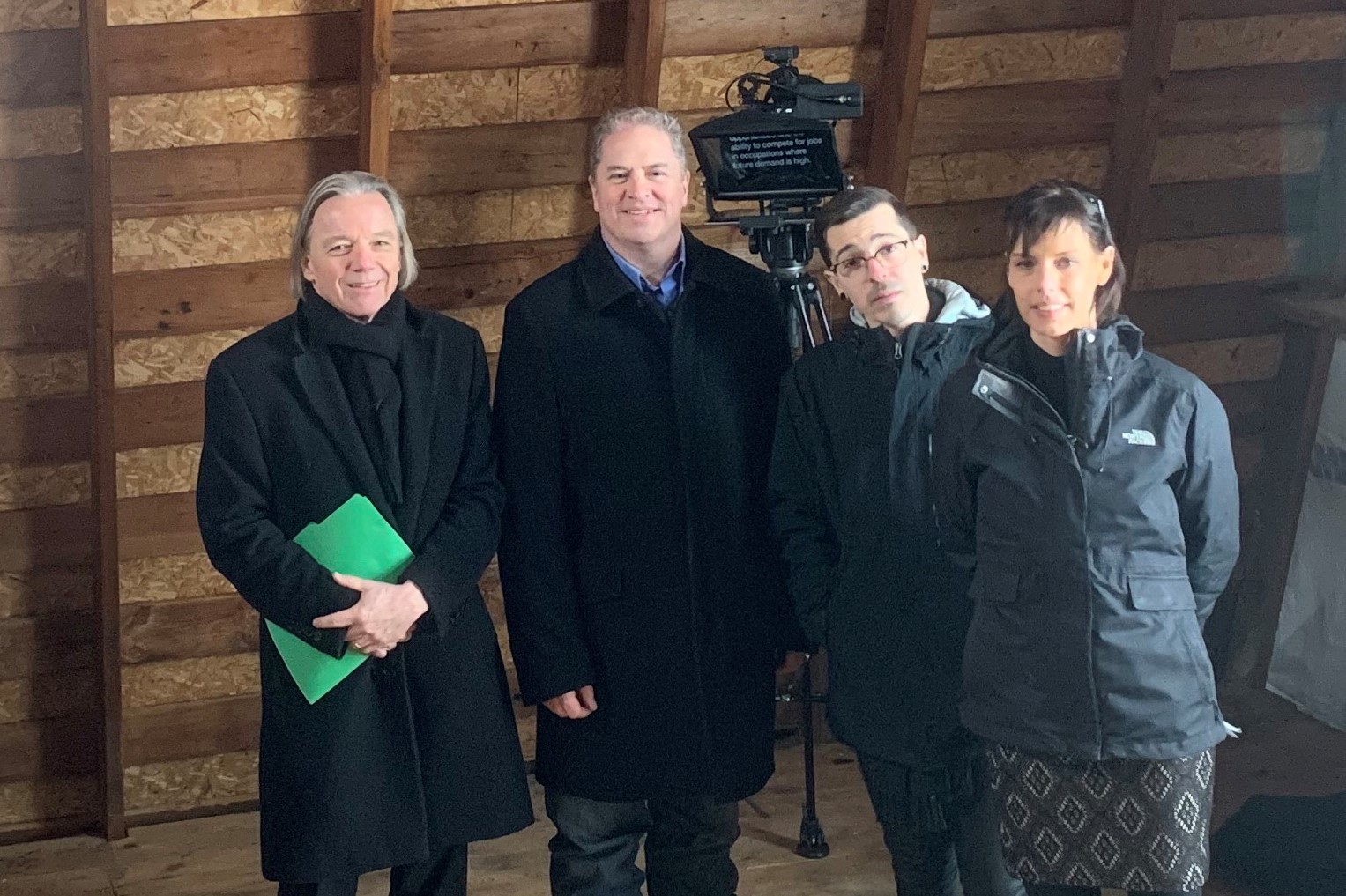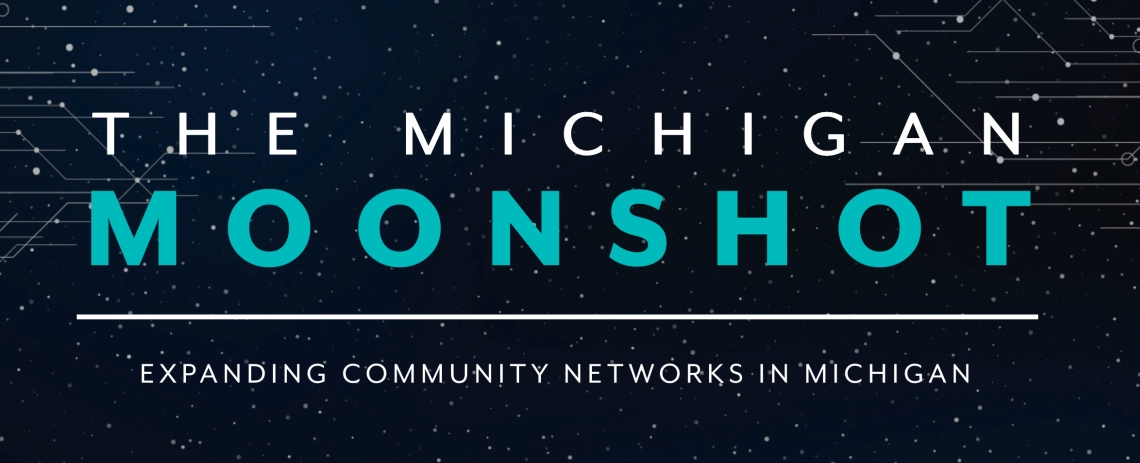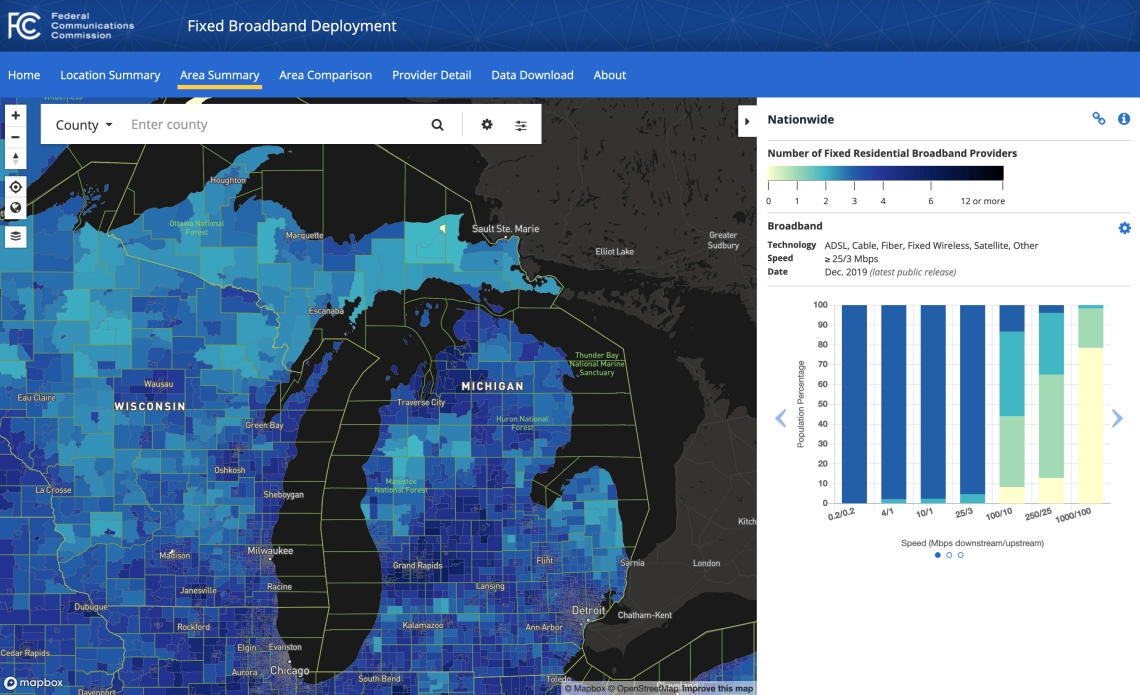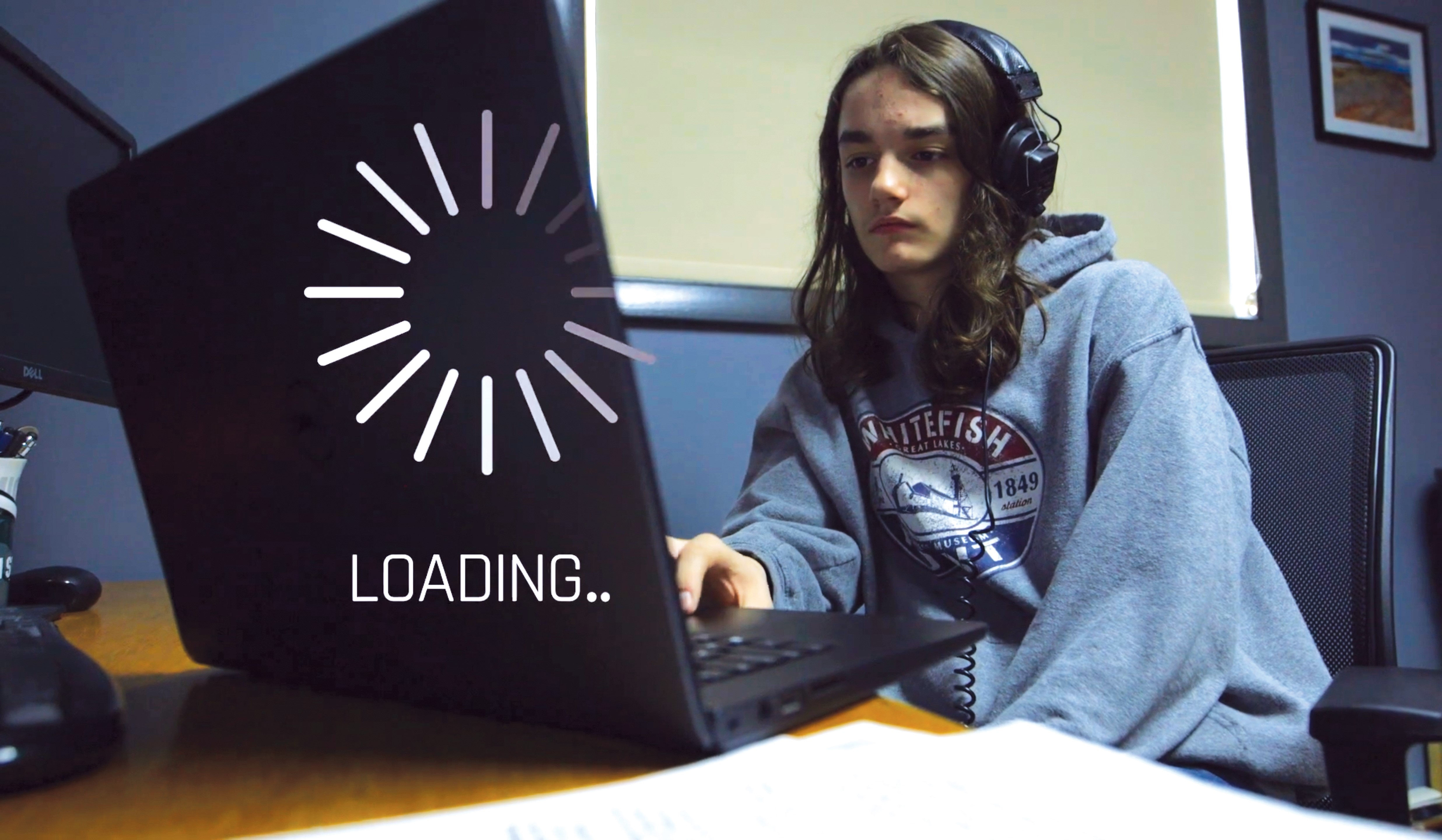Critical Connections: Rural Broadband Access and School Learning Gaps
- Keith Hampton, Ph.D.
- Professor and Quello Center Associate Director for Academic Research
- Department of Media and Information
- College of Communication Arts and Sciences
- Johannes M. Bauer, Ph.D.
- Professor, Quello Center Director, and Quello Chair in Media and Information Policy
- Department of Media and Information
- College of Communication Arts and Sciences

Left to right, Johannes Bauer, director, MSU Quello Center; Keith Hampton, director of academic research, MSU Quello Center; Craig Robertson, Ph.D. student; Laleah Fernandez, assistant director, MSU Quello Center
In groundbreaking research led by Keith Hampton, professor in MSU's College of Communication Arts and Sciences, and Johannes M. Bauer, professor and MSU Quello Center director, there is now evidence that middle and high school students who cannot connect sufficiently to the Internet at home are falling behind in educational accomplishments. It has been called the homework gap, but it's much more than that.
Partnering with Merit Network, a Michigan nonprofit with roots in technology development and advocacy, Hampton and Bauer worked with a network of collaborators to measure and quantify the realities of broadband access in rural communities, and what it means for educating Michigan's students.
Internet Access is Beginning to Affect Every Area of Life—and Our Children's Future
There is a growing divide between those who can and cannot access resources on the Internet. It impacts everything from workforce preparedness and college readiness to individual quality of life issues related to finances, health, shopping, news, entertainment, and more.
Educators and policymakers are focused on meeting the challenges required for teaching digital skills, but this fundamentally requires that students have access to reliable, affordable broadband service in their homes. Students who lack access to broadband Internet are increasingly at a disadvantage. And while it is usually thought of in terms of economically disadvantaged households, there is a need to understand and address the lack of access in rural regions that include farming communities and small towns.
Mary Beth Faba taught French at St. Clair High School for four years. Students often visited her classroom in the morning so they could use a computer to review, edit, or reformat their homework before class.
"They would work on a cell phone in the evenings because they didn't have any other option," said Faba. "It took them longer to do their homework on tiny screens, and then they still had more to do when they were able to get on a computer to reformat papers or study sheets to complete their assignments."
One student told Faba that high speed Internet was scheduled to be installed down their dirt road, but when the work was completed, it only reached as far as a cable worker's property. It stopped a few yards before the student's residence and homes farther along the road.
Building a Partnership
The Quello Center is a multi-disciplinary center within the Department of Media and Information of MSU's College of Communication Arts and Sciences. As director, Bauer works with faculty, researchers, research assistants, and collaborative partners to foster rigorous interdisciplinary research in technology, policy, and practice. Hampton is the director for academic research. The Quello Center has a strong track record of providing expertise and independent research to public and nonprofit institutions, as well as to the communication and Internet industry.
Hampton and Bauer share a strong commitment to working with partners who seek solutions to improve public understanding and access to technology. Their recent work with Merit (a longtime collaborator) included dozens of meetings and conversations about concepts, goals, research methodology, privacy of students and families, and public policy advocacy.
"It was an effort of love, it's fair to say," said Bauer.
The Michigan Education Research Information Triad (Merit) nonprofit was created in 1966 by Michigan State University, the University of Michigan, and Wayne State University. It was envisioned as a way to increase technology advances and connect mainframe computers at the three universities, as well as at other computer supercenters around the world. It was the beginning of the Internet frontier and much of the work sought to establish connections to strengthen collective efforts.
In Merit's 50-plus year history it has continued to uphold the principles of an open Internet with a mission to offer organizations advanced networking technology research, education, peer-to-peer connectivity, and collaborative initiatives.
 Merit launched the Michigan Moonshot Initiative in 2018. Described as a statewide call to action, it aimed to build a statewide ecosystem that can be leveraged to help local communities learn, plan, and take action to expand broadband access to all citizens in order to bridge the digital divide.
Merit launched the Michigan Moonshot Initiative in 2018. Described as a statewide call to action, it aimed to build a statewide ecosystem that can be leveraged to help local communities learn, plan, and take action to expand broadband access to all citizens in order to bridge the digital divide.
"The Moonshot is an expansion of Merit's mission as a nonprofit research and education network," said Charlotte Bewersdorff, Merit vice president for community engagement.
"Historically we have focused on high-capacity connectivity for community anchor entities like municipalities, libraries, and schools. But there are people living in Michigan communities that don't have equitable access to affordable broadband, and that needs to be addressed. This issue impacts so much within our lives, including online learning. We saw value in partnering with research faculty at MSU and the Quello Center for quantitative research that provided more information about ways in which lack of access has real and lasting impact on student outcomes."

Federal Communications Commission broadband map of Michigan.
The K12 Citizen Science Working Group and Building an "Ecosystem"
"We held a meeting in 2018 that called different stakeholders together to discuss shared interest in identifying information about gaps in broadband and student outcomes. There was representation from superintendents, curriculum specialists, teachers, administrators, and specialists from the Michigan Department of Education," said Hampton. "From that early discussion we asked for ISDs who would be interested in partnering with us to pilot an initiative to identify those gaps and consequences."
Three intermediate school districts (ISDs) volunteered to work with MSU and Merit Network to develop and pilot a plan:
Collectively, the three ISDs included fifteen participating school districts, along with the administrators and teachers in the schools and classrooms.
The collaboration led to an ambitious community-based research project with two primary goals:
Jason and Amy Kronemeyer were instrumental collaborators at those sessions.
"I met Johannes Bauer at a Michigan Moonshot meeting," said Jason Kronemeyer, director of technology at the Eastern Upper Peninsula Intermediate School District's Regional Educational Media Center. "He has been so involved in understanding the issues we have faced trying to get broadband access."
One of the issues has been inaccurate or poorly identified mapping of broadband access in rural or remote areas, as well as geographic pockets in more populated areas.
The first broadband map was made available in 2009 by the National Telecommunications and Information Administration. The Federal Communications Commission (FCC) now produces the information but relies on self-reporting from broadband service providers.
The research findings produced by Hampton and Bauer explain the deficits generated by this method and call out the need for improved data mapping to more accurately assess infrastructure development. The framework developed by their project methods addresses the granularity and accuracy needed to generate quantifiable, unbiased information.
"Keith's research was a critical part of what we needed to evaluate what can be done for students to improve their educational outcomes," said Amy Kronemeyer, director of student achievement for Sault Ste. Marie Area Public Schools in Michigan's Upper Peninsula. "Broadband access needs discussion at both local and federal levels. What if students who qualified for school lunch programs could also qualify for broadband access? That way, students in underserved areas have the same support for digital literacy."
How Are Research Findings Being Used?
- Research findings enable rural school districts to link gaps in home broadband connectivity to lower student performance, educational aspirations, and less interest in 21st century skills and careers.
- Local and county governments are using the pioneering mixed-method approach to data collection to identify broadband gaps in their communities.
- Research findings have contributed to a better understanding of the repercussions of discrepancies in broadband access for learning outcomes. They have helped decisionmakers write more compelling proposals to obtain funding to overcome short-term challenges and are helping in developing forward looking initiatives to address the problems in a sustained way.
- The approach to measuring broadband access speeds based on detailed and granular data, which was developed in the context of this project, has since been developed further and used by Merit Network and several community partners to develop better plans to overcome the broadband gap.
Broadband and Student Performance Gaps Report
Hampton and Bauer, along with Laleah Fernandez, Quello Center assistant director, and doctoral student Craig T. Robertson, authored the Broadband and Student Performance Gaps Report documenting the research and work designed and executed by the working group.
The report was released in early March 2020, and the timing couldn't have been better—or worse—for the findings on broadband access and student learning gaps. The coronavirus pandemic was emerging quickly, and there was a presidential impeachment process playing out in the nation's capital.
"Unbelievably enough, right at that moment we became incredibly irrelevant and incredibly relevant at the same time," said Hampton with a slight smile.
"Everything was beginning to close down because of the pandemic," he said. "It certainly pointed to the importance of broadband connectivity at home because schools were facing that reality. But it was a tough time to address it."
Among the significant findings:
- Information supplied by the federal government regarding data and mapping of broadband connectivity is insufficient and/or inaccurate and does not reflect the scope of geographic deficits in broadband access in rural areas.
- Students who do not have access to the Internet from home, or are dependent on a cell phone only, perform lower on a range of metrics, including digital skills, homework completion, and grades.
- Students lacking home Internet and those dependent on a cell phone are also less likely to consider post-secondary education.
- A deficit in digital skills compounds inequalities in access, contributing to lower standardized test scores and less interest in STEM (science, technology, engineering, and math) careers.
- Lack of broadband access not only impacts school performance, but also has broader repercussions for career choice, life income, and the ability to adapt to emerging demands of the workforce.

Students with highspeed home Internet access had overall grade point averages that were a half letter grade higher, the difference between a B and a B- average.
Coronavirus Pandemic Impacts
A year later, Michigan school districts are facing a new era. New methods of remote learning— including instruction, lectures, demonstrations, homework, and testing—are developing rapidly to reckon with a global pandemic.
"I don't think any of us realized that issues of access and inequality of access would become the dominant concern. I've sat through a record number of school board meetings since the report came out, and broadband access is a primary issue," said Hampton.
To introduce new methods to students, understanding who has broadband access, and how to get it to those who do not, is imperative.
"The framework that was created is applicable to other communities that want a more detailed reference of where the broadband access gaps are located," said Bauer.
"What started out as a commentary on public data has turned out to be useful and timely," he noted.
"We realized the implications of the pandemic meant that schools had to react quickly to get students online. That meant that we very quickly retooled after we released the report, and we put out a series of white papers about what schools should do—and steps to take—for equitable access. That was needed quickly to get their students online to finish the 2020 school year," said Hampton.
"Access is only a first step; it isn't enough," he said. "Students need to build their skills online to assure they can do what they need to do to accomplish online learning. That is also included in the report, but it was something that the pandemic implications really forced school districts to confront."
Future Projects

Internet connectivity is essential for students' college readiness, especially with rapidly developing methods of virtual and remote learning.
The Quello Center and Merit stakeholders continue to hold bi-weekly meetings. "We continue to keep the conversation alive. We are mulling over potential opportunities and exploring different paths of expansion; at the very least a statewide data set is needed," said Bewersdorff.
Hampton sees promise in sharing their research on data, mapping, and student performance gaps with other states and regions of the United States. "What we have done in Michigan can perhaps be applied to other communities," he said.
According to Bewersdorff, Merit has moved from research to local community action. "We are taking a very pragmatic approach," she said. "The data collection methodology developed by the Quello team is currently being used in projects with municipal and educational collaborators seeking granular and accurate broadband access and adoption information."
"Change has to be at the very local level, not a county level, but township by township," said Jason Kronemeyer.
An educator focused on student achievement, Amy Kronemeyer offers a broader viewpoint to policymakers: "Broadband Internet access should be like electricity, meaning it should be accessible and affordable to everyone."
As for future projects, Hampton, Bauer, and Bewersdorff each acknowledge the potential.
"It's always a long process to establish good relationships," said Bauer. "We see an opportunity to broaden the framework, and Keith and I have each reached out to other potential collaborators. Practically, conceptually, theoretically, we have a lot of thinking going on and we are sure some other things will come about from this work."
"The Quello Center study is one of a kind in the nation. They were able to control for all socioeconomic drivers and isolate the impact of broadband on students," said Bewersdorff. "It's absolutely phenomenal work that helps tell a story. As we see the industry poise for infrastructure funding, the topic of good data will be ever present. We've built a great foundation on principles of research, local user-driven data, utilizing an open-source platform, and in leveraging a community ecosystem—all which provides so much opportunity for everyone involved."
Several reports and policy briefs were created from this groundbreaking work:
- Hampton, K. N., Fernandez, L., Robertson, C. T., & Bauer, J. M. Broadband and student performance gaps. James H. and Mary B. Quello Center, Michigan State University. https://doi.org/10.25335/BZGY-3V91
- Bauer, J. M., Hampton, K., Fernandez, L. H., & Robertson, C. T. (2020, September). Overcoming Michigan's homework gap: The role of broadband Internet connectivity for student success and career outlooks. Michigan Applied Public Policy Research Paper; Quello Center Working Paper No. 06-20 (see Overcoming Michigan's Homework Gap: The Role of Broadband Internet Connectivity for Student Success and Career Outlooks | IPPSR (msu.edu)). (Report produced for MSU's Institute for Public Policy and Social Research)
- Hampton, K., & Bauer, J. M. (2020, March 26). Four things school districts need to know before moving learning online. MSU Today. Retrieved from Four things school districts need to know before moving learning online | MSU Today | Michigan State University
- Bauer, J. M., & Hampton, K. (2020). Broadband and student performance gaps: Designing short and long-term responses to the SARS-Cov-2 shutdown. Quello Center Policy Brief 02/20. Retrieved from Broadband and Student Performance Gaps — Quello Center | Michigan State University (msu.edu)
Sources
- Hampton, K. N., Fernandez, L., Robertson, C. T., & Bauer, J. M. Broadband and student performance gaps. James H. and Mary B. Quello Center, Michigan State University. https://doi.org/10.25335/BZGY-3V91
- Hampton, K. N., Fernandez, L., Robertson, C., & Bauer, J. M. (December 15, 2020). Repercussions of poor broadband connectivity for students in rural and small town Michigan. Available from SSRN: https://ssrn.com/abstract=3749644 or http://dx.doi.org/10.2139/ssrn.3749644
- Written by Carla Hills, University Outreach and Engagement
- Photos courtesy of MSU Quello Center, Merit Michigan Moonshot Initiative, Federal Communications Commission, College of Communication Arts and Sciences.